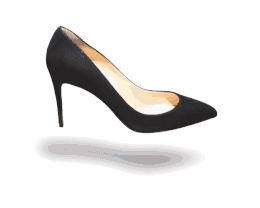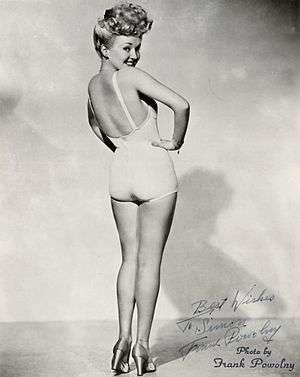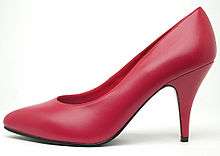High-heeled shoe

High heels are a type of shoe in which the heel, compared to the toe, is significantly higher off of the ground. These shoes go beyond simply protecting the foot from the ground or improve efficiency of walking. High heels make the wearer taller, accentuating the calf muscle and the length of the leg overall.[1] There are many types of high heels, which come in different styles, colors, and materials, and can be found all over the world. They have significant cultural and fashionable meanings attached to them, which have been largely shaped by historical contexts over the past 1000 years.
History
Pre-1700s

High heels have a long, rich history, dating as far back as the tenth century. The Persian cavalry, for example, wore a kind of boot with heels in order to ensure their feet stayed in the stirrups. Furthermore, research indicates that heels kept arrow-shooting riders, who stood up on galloping horses, safely on the horse.[2] Figure 1 shows that this trend has translated into the popular 21st century cowboy boot. Owning horses was expensive and time-consuming, so to wear heels implied the wearer had significant wealth.[3] This practical and effective use of the heel has set the standard for most horse-back riding shoes throughout history and even into the present day. Later, in the 12th century, in India, heels become visible again. The image of a statue from the Ramappa Temple proves this, showing an Indian woman’s foot clad in a raised shoe. Then, during the Medieval period, both men and women wore platform shoes in order to raise themselves out of the trash and excrement filled streets.[4] In 1430, chopines were 30 inches (76 cm) high, at times. Venetian law then limited the height to three inches—but this regulation was widely ignored.[5] A 17th-century law in Massachusetts announced that women would be subjected to the same treatment as witches if they lured men into marriage via the use of high-heeled shoes.[6]
1700s

Modern high heels were brought to Europe by emissaries of Shāh Abbās I of Persia in the early 17th century.[7] Men wore them to imply their upper-class status; only someone who did not have to work could afford, both financially and practically, to wear such extravagant shoes. As Figure 2 depicts, royalty such as King Louis XIV wore heels to impart status. As the shoes caught on, and other members of society began donning high heels, elite members ordered their heels to be made even higher to distinguish themselves from lower classes.[8] Authorities even began regulating the length of a high heel’s point according to social rank. Klaus Carl includes these lengths in his book Shoes: “½ inch for commoners, 1 inch for the bourgeois, 1 and ½ inches for knights, 2 inches for nobles, and 2 and ½ inches for princes.”[9] As women took to appropriating this style, the heels’ width changed in another fundamental way. Men wore thick heels, while women wore skinny ones. Then, when Enlightenment ideals such as science, nature, and logic took hold of many European societies, men gradually stopped wearing heels.[8] After the French Revolution in the late 1780s, heels, femininity, and superficiality all became intertwined.[3] In this way, heels became much more associated with a woman’s supposed sense of impracticality and extravagance.

The design of the high French heels from the late 1600s to around the 1720s placed body weight on the ball of the foot, and were decorated with lace or braided fabric (Figure 3). From the 1730s-1740s, wide heels with an upturned toe and a buckle fastening became popular. The 1750s and 1760s introduced a skinnier, higher heel. The 1790s continued this trend, but added combinations of color. Additionally, throughout all of these decades, there was no difference between the right and left shoe.[10]
In Britain in 1770, an act was introduced into the parliament which would have applied the same penalties as witchcraft to the use of high heels and other cosmetic devices.[11]
1800s

Heels went out of fashion starting around 1810, and then in 1860 they returned at about two and a half inches. The Pinet heel and the Cromwell heel were both introduced during this time.[12] Their production was also increased with the invention and eventual mass production of the sewing machine around the 1850s. With sewing machines, yields increased as machines could quickly and cheaply “position[n] the heel, stitc[h] the upper, and attac[h] the upper to the sole.”[9] This is also a prime example of how the popularity of heels interacts with the culture and technology of the time.
1900s

With the 1900s bringing two devastating world wars, many countries set wartime regulations for rationing almost all aspects of life. This included materials previously used for making heels, such as silk, rubber, or leather; these began to be replaced with cork and wooden soles.[13] Another one of the numerous outcomes of these wars was an increase in international relations, and a more proliferate sharing of fashion through photography and films, which helped spread high heel fashion as well.[9] Examples of this were the brown and white pumps with cutouts or ankle straps combined with a peep toe.[13] Their practicality yet professional look appealed to the new, fast-paced lifestyle of many women.
Alternatively, World War II led to the popularization of pin-up girl posters, which men would often hang in their bunks while at war. Almost all of these girls were pictured wearing high heels, leading to an increase in the relationship between high heels and female sexuality.[3] The tall, skinny stiletto heel was invented in 1950, strengthening the relationship between women, sexuality, and appearance.[10]
21st century
The intricate and complex history of high heels has led to a variety of cultural thoughts and lens through which people view them today. Firstly, it is very exclusively gendered in the sense that few men wear high heels in present times.[4] Secondly, magazines like Playboy, as well as other media sources portraying women in a sexual way, often do so using high heels. Paul Morris, a psychology researcher at the University of Portsmouth, argues that high heels accentuate "sex specific aspects of female gait", artificially increasing a woman's femininity.[4] Respectively, the arching of a woman's back facilitated by wearing high heels signals a woman's willingness to be courted by a man.[14][15] Keeping this sexual undercurrent in mind, heels are considered fashionable for women in most cases. It could be semiformal with a “button down silk blouse…jeans and high heels.”[16] Or, it could be formal with a dress or pants suit. Finally, 20th and 21st century cultural values have dictated that high heels are the norm in professional settings for a woman. Some researchers argue that high heels have even become part of the female workplace uniform, and operate in a much larger and complex set of display rules.[4] High heels are considered to pose a dilemma to women as they bring them psychosexual benefits but are detrimental to their health.[17] The 21st century has introduced a broad spectrum and variety of styles, ranging from height and width of heel, to design and color of the shoe.
Types
- Stacked heel – usually layers of leather 5 mm thick stacked together and trimmed to match the shape of the heel.[1] These are commonly known as block heels.
- Continental heel – 7.5 mm, with the upper part of the chest of the heel spreading towards the center of the shoe.[1]
- Setback heel – similar to the continental heel, but the surface of the back of the heel is straight, forming a right angle.[1]
- Cuban heel – similar to the continental heel, but not curved, generally medium height[1]
- Pantaloon heel – "similar to pantaloon pants: the top lift part of the heel is spread out as it extends to the bottom part of the heel, and the waistline of the heel is curves inward naturally."[1]
- Angle heel – "the surface of the base of the heel is straight until reaching the waistline, and it looks like the shape of the Korean letter ¬"[1]
- Pinet heel – straight and skinny[12]
- Cromwell shoe – based on Oliver Cromwell with heel up to 170 mm (6.5 in).[12]
- Bar Style – had jewelry or other decorative aspects to go along with flapper culture.[12]
- New Look in 1947 – a slim/elegant heel, newly discovered by putting steel in the heel. This enabled the heel to be ultra skinny without snapping.[12]
- Annabelle – 7 cm platform heel[18]
- Stiletto – Tall, skinny heel; first mentioned in a newspaper in September 1953.[12]
- Wedgies - These were popularized by Salvatore Ferragamo, who introduced this in the italian market in the late 1930s[19].
Materials
High heels have been made from all kinds of materials throughout history. In the early years, leather and cowhide was preferred. As civilizations progressed, silk and patent leather were introduced, while cork and wood were utilized as cheap resources in times of war.[13] After the World Wars and the increase in production of steel, the actual heel was a piece of steel wrapped in some kind of material. This has enabled designers to make heels taller and skinnier without them snapping.[20]
Medical research

Joint and back pain
A systmatic review of 2016 found the wearing of high-heeled shoes to be associated with hallux valgus, musculoskeletal pain and first-party injury.[21]
Research has shown correlation between the height of a heel and the amount of injury that results. Specifically, high heels can affect the amount of tension present in the paraspinal muscles, or muscles running up the back along the spine. Because humans typically stand with flat feet, the bodies’ muscular response to the unnatural feeling of wearing high heels is to tense, causing back, leg, and even shoulder muscles to tighten in order to improve balance and stability. Some more specific instances of the numerous negative side effects of wearing heels include ankle sprains, back and leg pain, shortening of the Achilles tendon, and loss of joint mobility in the wearer's knees. In particular, shoes with only a small space for the toes, can sometimes squeeze tightly enough to cause foot deformity. Additionally, heels may affect how the wearer walks by slowing and shortening their normal stride.[1]
Vein swelling
Further research reveals that another possible consequence of wearing high heels is an increase of pressure in one's veins. Experiments have proven that the higher the heel, the “higher [the] venous pressure in the leg.” This means that after repeated use of high heels, varicose veins and other undesirable symptoms are much more likely to appear in the legs.[18] Other research supports these two claims when arguing that wearing high heels can lead to numerous long term effects, including accidental trauma to multiple areas of the body.[4]
Feminist attitudes
Research shows that heels draw attention to long legs and small feet. Some argue that “high-heeled shoes, perhaps more than any other item of clothing, are seen as the ultimate symbol of being a woman.”[12] High heels often play a key role in emphasizing a wearer's, most commonly a woman's, arched back and extended buttocks. This “natural courting pose” sexualizes the wearer, and can turn them into objects subjected to the male gaze.[2] This research highlights the emphasis heels place on the appearance of the wearer, instead of their arguably more valuable internal traits such as intelligence, creativity, or strength.
It has not been popular for men to wear high heels since the late 18th century.[3] Some men see the cultural norm, which often mandates that women must wear heels to look professional, as completely unproblematic.[22] However, women report that they are often painful to walk in,[1] and commonly result in negative side effects to joints and veins after prolonged use.[18]
At the feminist Miss America protest in 1968, protestors symbolically threw a number of feminine products into a "Freedom Trash Can." These included high-heels,[23] which were among items the protestors called "instruments of female torture"[24] and accouterments of what they perceived to be enforced femininity.
In 2015, a group of women were turned away from a film première at the Cannes Film Festival in France for wearing flat shoes, including a woman physically unable to wear heels due to an operation on one of her feet.[25] The women complained that this was a sexist policy which forced women into a stereotyped appearance; festival organisers later responded that there was no official policy on footwear and stated that they would remind red carpet officials of this.[9][26]
Some dress codes require women to wear high heels, and there have been repeated feminist protests by women workers against such policies.
A Mile in Her Shoes

Protests like A Mile in Her Shoes are one of the few instances in the 21st century where it is socially acceptable for heterosexual men to wear high heels. In this march men wear red high heels and walk a mile in protest of domestic violence. Some academics have suggested that by wearing high heels for such a brief period of time, and making a point of acting like they do not know how to walk properly in them, these men are reinforcing the stereotype that only women can or should wear high heels.[27]
Dancing
Some dancers such as Yanis Marshall specialize in dancing with high-heels.[28]
See also
References
- 1 2 3 4 5 6 7 8 9 Han, Dongwook. “Muscle Activation of Paraspinal Muscles in Different Types of High Heels during Standing.” Journal of Physical Therapy Science, vol. 27, no. 1, 2015, pp. 67–9., doi:10.1589/jpts.27.67.
- 1 2 Kremer, William. “Why did Men Stop Wearing High Heels?” BBC World Service. 26 Jan 2013.
- 1 2 3 4 Trufelman, Avery. “Feet of Engineering.” 99% Invisible. Jun 2014.
- 1 2 3 4 5 Morris, Paul; Jenny White; Edward Morrison; Kayleigh Fisher (May 2013). "High Heels are Supernormal Stimuli: How Wearing High Heels Affects Judgments of Female Attractiveness". Evolution and Human Behavior. 34 (3): 176–181.
- ↑ Margo DeMello (2009). Feet and Footwear: A Cultural Encyclopedia. Greenwood Press/ABC-CLIO. p. 311. ISBN 978-0-313-35714-5.
- ↑ Margo DeMello (10 September 2009). Feet and Footwear: A Cultural Encyclopedia. ABC-CLIO. p. 323. ISBN 978-0-313-35715-2.
- ↑ Kremer, William (25 January 2013). "Why did men stop wearing high heels?". bbc.com. BBC. Retrieved 20 June 2018.
- 1 2 Wade, Lisa. “From Manly to Sexy: The History of the High Heel” The Society Pages. 5 Feb 2013.
- 1 2 3 4 Carl, Klaus. Shoes. New York, Parkstone International, 2011. EbscoHost.
- 1 2 Blanco F José, et al., editors. Clothing and Fashion : American Fashion from Head to Toe. Santa Barbara, California, ABC-CLIO, an Imprint of ABC-CLIO, LLC, 2016. Print.
- ↑ John Brookes (1859), Manners and Customs of the English Nation, James Blackwood, pp. 261–262,
In the year 1770 an act was introduced into Parliament against hoops, false hair, high heels...
- 1 2 3 4 5 6 7 Shawcross, Rebecca. “High Heels.” The Berg Companion to Fashion. Ed. Valarie Steele. Oxford: Bloomsbury Academic, 2010. Web.
- 1 2 3 Stabb, Jo Ann. “The Early 20th Century Through World War II” Clothing and Fashion: American Fashion from Head to Toe, edited by Jose Blanco, vol. 3 ABC-CLIO, pp. 330-332. Gale Virtual Reference Library.
- ↑ Elizabeth Hawkins (Oct 25, 2017). "Why arched backs are attractive". springer.com.
- ↑ Pazhoohi, F.; Doyle, J.F.; Macedo, A.F.; Arantes, J. (2017). "Arching the Back (Lumbar Curvature) as a Female Sexual Proceptivity Signal: an Eye-Tracking Study". Evolutionary Psychological Science: 1–8. doi:10.1007/s40806-017-0123-7.
- ↑ Women’s Dress and Fashion, 1980-Present” Clothing and Fashion: American Fashion from Head to Toe, edited by Jose Blanco, vol. 4 ABC-CLIO, pp. 321-325. Gale Virtual Reference Library.
- ↑ Barnish M, Morgan HM, Barnish J (August 2017). "The 2016 HIGh Heels: Health effects And psychosexual BenefITS (HIGH HABITS) study: systematic review of reviews and additional primary studies". BMC Public Health (Review). 18 (1): 37. doi:10.1186/s12889-017-4573-4. PMC 5537921. PMID 28760147.
- 1 2 3 Filho, Wagner, Nei Dezzotti, Edvaldo Joviliano, Takachi Moriya, Carlos Piccinato. “Influence of High-Heeled Shoes on Venous Function in Young Women.” Journal of Vascular Surgery, vol. 56, Oct 2012.
- ↑ "Wedge(footwear)_wikipedia".
- ↑ Schwartz, Jessica. “Stiletto Heels.” Clothing and Fashion: American Fashion from Head to Toe, edited by Jose Blanco, vol. 4: The Postwar Period into the 21st century, ABC-CLIO, pp. 281-282. Gale Virtual Reference Library.
- ↑ Barnish MS, Barnish J (January 2016). "High-heeled shoes and musculoskeletal injuries: a narrative systematic review". BMJ Open (Review). 6 (1): e010053. doi:10.1136/bmjopen-2015-010053. PMC 4735171. PMID 26769789.
- ↑ Reynaud, Bérénice. “These Shoes Are Made for Walking.” Afterall: A Journal of Art, Context and Enquiry, no. 6, pp. 42–51. 2002.
- ↑ Dow, Bonnie J. (Spring 2003). "Feminism, Miss America, and Media Mythology". Rhetoric & Public Affairs. 6 (1): 127–149. doi:10.1353/rap.2003.0028.
- ↑ Duffett, Judith (October 1968). WLM vs. Miss America. Voice of the Women's Liberation Movement. p. 4.
- ↑ "Emily Blunt on Cannes heels row: 'everybody should wear flats'". The Telegraph. Retrieved 16 May 2016.
- ↑ "Cannes denies high-heel rule for women on red carpet". www.yahoo.com. Retrieved 16 May 2016.
- ↑ Bridges, Tristan. “Men Just Weren’t Made to do This: Performances of Drag at ‘Walk a Mile in Her Shoes’ Marches.” Gender and Society, vol. 24, no. 1, 2010, pp. 5–30. JSTOR.
- ↑ YANIS MARSHALL (28 December 2015). "Yanis Marshall - The Choreographer - Zumanity: Rated Cirque - Ep. 1- Cirque Du Soleil" – via YouTube.
External links
![]()
